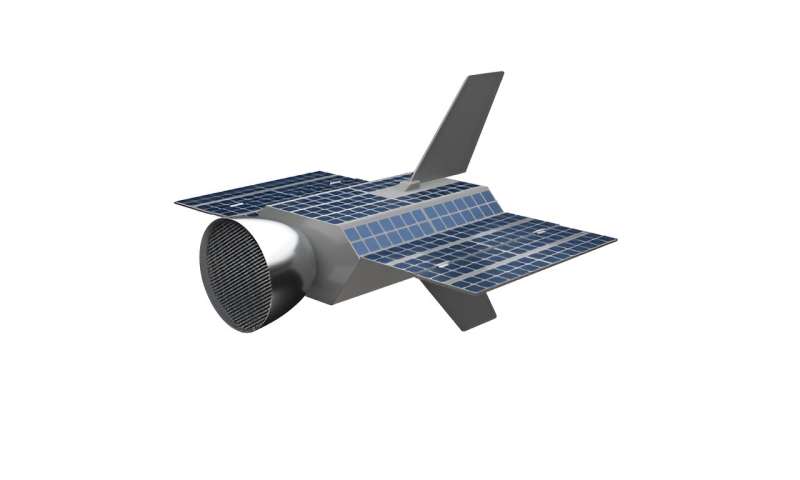New CRC ATLAS researches technologies for space missions at very low altitudes

The German Research Foundation (DFG) has given the green light for a new Collaborative Research Center "Advancing Technologies of Very Low Altitude Satellites" (SFB 1667 ATLAS). Under the leadership of the University of Stuttgart, scientists are aiming to develop a technological basis for the sustainable use of Very Low Earth Orbits (VLEO). This area offers great potential for improving scientific and commercial satellite missions and ensuring they are fit for the future.
"The new ATLAS Collaborative Research Center is making a fundamental, pioneering and indispensable contribution to the future of space utilization, engaging in pioneering work for the sustainable use of satellites," explains Professor Wolfram Ressel, Rector at the University of Stuttgart. "Its interdisciplinary team unites excellent scientists who are working together to implement the Stuttgart Way and develop intelligent systems for a sustainable society."
Making VLEO usable for satellite services
Researchers at the University of Stuttgart and the German Aerospace Center (DLR) want to increase the service life of satellites in this area from around six months, to several years, without having to carry or be resupplied with large quantities of fuel from Earth. The small, economical and sustainable satellites of the future are to be deployed at an altitude of about 200 to 450 kilometers above the earth's surface, an altitude that they have not been able to utilize before, known as the VLEO.
"We want to develop the necessary scientific foundations to exploit this potential and thus make indispensable satellite services fit for the future. Such satellites are particularly important in the fields of Earth observation, communication, and climate research," says Professor Stefanos Fasoulas, spokesperson for the ATLAS CRC and Managing Director of the Institute of Space Systems (IRS) at the University of Stuttgart.
An area with lots of untapped potential
In VLEO, earth observation missions can be carried out with higher resolution, and communication applications can operate with shorter time delays. Satellite systems used in low-altitude orbits are smaller and lighter and, due to their proximity to the earth, can be put into orbit at lower cost. VLEO is also an area that enables new research missions, which are the focus of the application scenarios investigated by the CRC ATLAS. Furthermore, satellites in this area do not remain in orbit as space debris after they have served their purpose, as they decelerate so much that they quickly lose altitude and ultimately enter the lower layers of the atmosphere, where they burn up quickly.
Making satellite operations economical
However, this strong deceleration of the satellites also poses the greatest challenge for the scientists in order to enable permanent and thus economically viable satellite operation in this area. Due to complex interactions between solar radiation, the Earth's magnetic field and the uppermost layer of the atmosphere in which the satellites orbit the Earth, the deceleration process is very dynamic, extremely difficult to predict and has been the subject of very little research to date. New types of thrusters, which are being researched at the CRC, may be key to counteracting this deceleration and keeping the satellites permanently in orbit.
Volatile boundary conditions
"If we want to deploy satellite systems in VLEO, we have to understand and master these volatile conditions and incorporate them into the mission plan," explains Professor Fasoulas. The researchers are investigating the question of how the prevailing residual atmosphere, i.e., the remaining gas particles, can be used. In three project areas within ATLAS, they want to analyze the framework conditions for future scientific satellite missions in VLEO, develop new solutions for components and satellite subsystems, such as novel propulsion systems or an efficient energy supply, and investigate the interactions between the very thin residual atmosphere and surfaces under VLEO conditions.
Internationalization and long-term perspectives
The aim of the new Collaborative Research Center is to provide the international space community with new methods and technologies that will enable reliable studies and the development of specific mission scenarios in VLEO. Among other things, this could pave the way for new quantum technology applications that would make our real-time communication more secure or measuring instruments more powerful. "We want to ensure that this becomes a global topic, and with ATLAS we are implementing a research idea that should be sustainable in the long term," emphasizes Fasoulas.
About the CRC 1667 ATLAS
The Collaborative Research Center 1667 "Advancing Technologies of Very Low Altitude Satellites" (ATLAS) will initially be funded by the German Research Foundation (DFG) for four years. The interdisciplinary researchprojects are scheduled to run for a total of 12 years. Under the leadership of the University of Stuttgart, the CRC comprises 25 sub-project leaders from 14 institutes belonging to six faculties of the University of Stuttgart and the Institute of Technical Physics at the German Aerospace Center (DLR-TP).
Provided by Universitaet Stuttgart